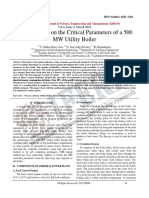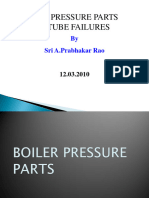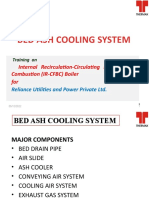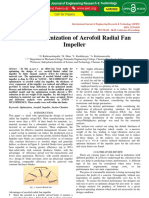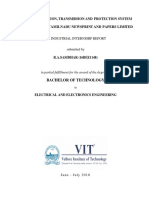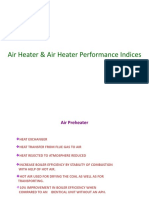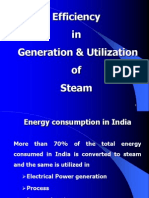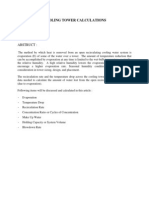Boiler Optimization PDF
Boiler Optimization PDF
Uploaded by
vijayk1968Copyright:
Available Formats
Boiler Optimization PDF
Boiler Optimization PDF
Uploaded by
vijayk1968Original Description:
Original Title
Copyright
Available Formats
Share this document
Did you find this document useful?
Is this content inappropriate?
Copyright:
Available Formats
Boiler Optimization PDF
Boiler Optimization PDF
Uploaded by
vijayk1968Copyright:
Available Formats
Boiler optimisation
This infosheet contains information about:
n
different boiler applications;
optimising the performance of boilers; and
efficient steam systems.
A new steam trapping system resulted in immediate
fuel savings of around $160 000 per year for a
major milk powder producer.
INTRODUCTION
Optimising the performance of a boiler and its
associated steam distribution system reduces running
costs and improves site operations. Steam is used
extensively in industry as a heat transfer fluid and as a
source of energy to power mechanical plant and
equipment. As a heat transfer fluid, steam has an
advantage over fluids such as hot water and oil. It is able
to store very large quantities of heat, which can be given
up at constant temperature as the steam condenses.
Unfortunately more energy is lost in industry through
steam wastage than through any other medium.
Research studies by industry experts in the early
1990s suggested that losses from steam systems
make up approximately 35% of all identified potential
energy savings.
BOILER APPLICATIONS
Steam is produced in two types of boilers.
Water tube boilers
Water tube boilers are usually used in large industrial
and power generation situations where extremely high
heat transfer rates are required to produce large
quantities of steam. The water is heated in tubes and
the fire (combustion process) is contained in the space
around the tubes.
Fire tube boilers
Fire tube boilers are used in the more typical industrial
and commercial boilers, which generally require lower
steam generation or have limited space. In this case
the fire, or the hot combustion gases, are contained
inside tubes within the boiler and the water is
circulated around these tubes.
The steam generated by boilers can be used in
two ways:
n
at high pressure (> 4200 kPa) to drive turbines
or reciprocating engines; and
at low pressure (7001400 kPa) to supply heat to
heating coils etc., or by direct injection into fluid.
In some plants, a combination of these uses is
employed. The resulting high-pressure superheated
steam is used to drive a turbine for the generation of
electricity, and the turbine exhaust steam is used for
heat transfer applications. In these systems the
condensate is generally returned to the boiler for
re-use, and the overall efficiency is almost 80%.
In most industrial and commercial plants, steam is
only used for process and environmental heating.
It is important to optimise the efficiency of each
part of such systems through proper selection, sizing,
operation and maintenance.
Steam should be distributed to the end-use locations
at the highest practical pressures to minimise pipe sizes
and subsequent heat losses. At the same time, however,
it should be used at the lowest possible pressures to
take advantage of the greater latent heat available at
lower pressures. This minimises the formation of flash
steam from the discharged condensate.
In industrial processes, the decision to use either
heating coils/jackets or direct steam injection is
determined by the:
n
required rate of heat transfer;
agitation of solutions;
nature of the product;
operating temperatures; and
cost of feed-water treatment.
A typical steam system (see Figure 1) uses the steam
for direct process heating in the injection vessel, and
for indirect heating through the indirect heating coil.
B E ST P RA C T IC E D ES IG N, T EC HN OL OG Y A ND M AN A G EM E NT
39
Figure 1: Simple industrial steam system
EFFICIENT OPERATION
For boiler optimisation it is important to address both
the combustion system, and the steam and feedwater systems.
Combustion efficiency
Combustion efficiency indicates the flue gas loss.
Boiler efficiency also includes the blowdown and
stand-by losses. Whether comparing new or existing
boilers, their most efficient operating point is usually
somewhere between 60% and 90% load.
Stable combustion requires three inputsfuel, oxygen
and a source of ignition. If the combustibles can
provide this third element as they burn, the source of
ignition can be turned off. In complete combustion a
number of things happen:
n
carbon in the fuel is converted to carbon dioxide;
hydrogen in the fuel is converted to water vapour;
and
sulfur and nitrogen in the fuel, and in the air
supplied for combustion, are converted to their
oxides.
In theory, there is a precise and predictable amount
of oxygen needed to completely burn a given amount
of fuel. This is called stoichiometric air. In practice,
however, burning conditions are never ideal and more
air must, therefore, be supplied to completely burn
the fuel. The amount of air above the theoretical
requirement is referred to as excess air.
40
BES T P R AC TI C E DE SI GN , T EC H NOL O GY AN D M A NA GE M EN T
If insufficient air is supplied to the burners, unburned
fuelsoot and smoke, and carbon monoxide (the
incomplete conversion to carbon dioxide)appear in
the exhaust from the boiler stack. These can result in:
n
the heat transfer surface fouling;
pollution;
lower combustion efficiency;
flame instability (i.e. the flame blows out); and
the potential for an explosion.
Operating boilers at excess air levels provides:
n
protection from costly and potentially unsafe
conditions;
operating protection from an insufficient oxygen
condition caused by variations in fuel composition;
and
operating slop in the fuel/air control system on
the boiler.
Flue gas loss (100% minus combustion efficiency)
is usually the largest factor in reducing a boilers
efficiency. Stack temperature and O2 levels are the
main factors that determine combustion efficiency.
Most boilers lose between 15% and 20% of their
fuel energy input up the stack. A gradual decrease
in boiler efficiency often indicates the need for one,
or a combination, of the following:
minor adjustments or repairs in the control linkages,
fuel valve or air damper;
the replacement of a worn burner tip or control
cam; and
the cleaning of stack surfaces (heat transfer
effectiveness is reduced when the surface becomes
fouled by a coating of insulating materialsoot on
the gas-side, or scale on the water or steam side).
An insufficient air-to-burner ratio can be dangerous.
On the other hand, air flows greater than those
needed for stable flame propagation and complete
fuel combustion needlessly increase flue gas flow
and consequent heat losses, and thereby lower boiler
efficiency. Minimising these losses requires monitoring
and periodic tuning. Ideally, the fuelair ratio is
automatically controlled based on the percentage of
O2 in the stack, and on an unburned hydrocarbons
indication. These automated systems are called O2 trim
packages. They will minimise the level of excess air and,
therefore, reduce the flue gas losses. Savings in fuel
economy may exceed 2%, which on a 5 MW size boiler
is significant, and a payback period of one to three
years can be achieved.
Flue gas recirculation
One of the many ways to reduce NOx emissions is
to use flue gas recirculation, a method that recycles
some of the exhaust gases back to the burner.
Flue gas recirculation has the following effects.
n
The heat content of the exhaust air contributes
to heat recovery.
The reduced oxygen content of the exhaust gases
lowers the flame temperature in the combustion
zone, thereby reducing NOx formation.
The reduced flame temperature lowers heat
transfer, potentially limiting the maximum heating
capacity of the unit. (It would not be unusual for a
boiler retrofitted with flue gas recirculation to
produce a 10% reduction in maximum steam
generating capacity.)
Gas-side fouling
The easiest fouling condition to correct is normally
the gas-side deposits. Natural gas generally does not
produce significant gas-side deposits if the burner is
functioning properly. Fuel oil combustion deposits consist
predominately of soft, black soot and are easily removed
with brushing. Lower grade fuel oil may contain large
quantities of alkaline sulfates and vanadium pentoxide
that cause more serious gas-side deposits.
These compounds have low fusion temperatures causing
them to slag and become deposited on convection
surfaces. Solid fuels, including coal and wood, produce
deposits that contain ash-based slag and soot.
Boiler gas-side temperatures are so high that ash
deposits on convection surfaces (that could have been
easily removed as they formed using a soot blower)
can become sintered, or melted, into glass-like masses
known as enamel. Any type of tube fouling acts as an
insulator between the flue gas and convection surface,
reducing the efficiency of the boiler or heater.
The cost of poorly maintained boiler tubes can be
estimated from the increase in stack temperature
compared to clean conditions.
The loss of boiler efficiency is approximately 1% for
every 4.5C increase in stack temperature above
baseline conditions.
Table 1: Required cleaning for boilers
Type of boiler
Cleaning required
Small fire tube boilers
Manual brushing on the gas-side surface
Boilers using distillate fuel oil
Monthly brushing
Fire tube units burning solid fuel
Weekly, or even daily, cleaning needed to prevent ash
deposits from becoming sintered and difficult to remove
Water tube boilers using low quality fuel
Large deposits can be removed automatically with a high-pressure blast
Soot blowing may be needed as often as once per shift
B ES T P RA C TI C E D ESI G N, TE C HN O L OG Y A ND M AN A G EME NT
41
STEAM DISTRIBUTION EFFICIENCY
Leaks and losses
Heat recovery
Stand-by losses
There are a number of ways to recover heat.
About 1.52.0% of the rated boiler fuel input is lost to
the engine room. While this loss is small when boilers
operate at or near their rated capacity, it can be
significant where boilers operate frequently at low
loads. For example, imagine a boiler rated at 10 GJ/hr
fuel input but operating at a 2 GJ/hr level.
Process product heat recovery
In applications where steam is used for direct process
heating, and the steam is lost to the process and
vented to the atmosphere, it is difficult to recover the
liberated condensate economically. In these situations
it may still be possible to capture the waste heat from
the process through the installation of a heat recovery
system which uses the process liquid to pre-heat the
feed-water makeup. This can be achieved by the
insertion of a shell and tube heat recovery system as
shown in Figure 2.
The stand-by loss of 2% of 10 GJ/hr is 200 MJ/hr.
This is the reason why plants with large seasonal
variations in steam-use install small boilers to operate
during the summer rather than operate large boilers
year round.
Steam leaks
On its journey through the distribution system, steam
will lose energy in many ways. These losses are
difficult to avoid, but must be kept to a minimum.
Leaking steam is the most obvious and serious of all
losses. These losses occur through faulty valves, joints
and steam traps. Even a small leak can result in
considerable steam and, consequently, energy loss.
For example, a 1 mm diameter hole on a steam line at
700 kPa will result in an annual energy loss equivalent
to 3000 litres of fuel oil or 4300 m3 (166 GJ or around
$1000) of natural gas per year.
Figure 2: Heat tube recovery system
In this situation the boiler makeup water would be
passed through the cold fluid line and the process fluid
would be passed through the hot fluid line. The energy
performance of the shell and tube type of heat
exchanger depends on the application, but may be as
high as 8090%. Shell and tube heat recovery units
can be designed to manage most operating conditions
and temperatures up to 500C.
Figure 3 provides a quick guide for estimating the
quantity of steam that is lost through leaks simply by
measuring the length of the steam plume emanating
from a leak.
Blowdown heat recovery
Blowdown heat recovery (generally applicable to larger
boilers) is simple and effective at preheating incoming
feed-water. Blowdown rates typically range from 48%
of total steam generated, but can be as high as 10% if
incoming water has high solids content. In any case,
this water has significant heat content that can easily
be recovered. For example, if a 150 psig saturated
steam boiler generates 4550 kg/h of steam and has a
blowdown rate of 10%, the heat recovery potential is
~0.22 GJ per hour. At a fuel cost of $4/GJ, and 80%
combustion efficiency, an annual saving of about
$8400 could be achieved. Demineralising this feedwater may also reduce blowdown requirements.
42
BE S T P RA CT IC E D E S IGN , T ECH N OL O G Y A N D M ANA G EM EN T
Figure 3: A quick guide for estimating the quantity
of steam lost through leaks
Pipe losses
Steam pipes can be a major source of concern due
to direct heat transfer losses. Adequate insulation is
essential. For example, a one metre length of uninsulated
steam pipe carrying steam at 700 kPa will loose heat at
an annual rate equivalent to 1000 litres of fuel oil or
650 m3 (25 GJ or around $150) of natural gas per year.
Although lagging of pipes is common practice in most
plants, lagging of flanges, valves and other pipeline
fittings is not. The heat loss from an uninsulated flange
is equivalent to the loss from 600 mm of uninsulated
pipe. A glove valve can loose heat at the rate
equivalent to a five metre length of pipe. While these
flanges and fittings are usually not insulated (to allow
ease of maintenance access), the amount of energy
lost outweighs any maintenance time saving.
Figure 4 provides a guide to heat losses from a one
metre length of uninsulated pipe of varying internal
diameters for different pipe temperatures
There are four groups of traps:
n
mechanical;
thermostatic;
thermodynamic; and
miscellaneous.
Condensate return
Condensate discharged from process plant may
contain up to 25% of the heat added in the boiler and
in addition will be chemically treated water. Any
sensible heat still left in the condensate should be
returned to the feed tank. This water is free of
impurities and every 5C increase in the feed-water
temperature will save approximately 1% of the fuel
used to raise steam. Again, to maximise the recovery
of sensible heat, condensate lines should be insulated.
Waterside fouling
Figure 4: Heat losses from a one metre length
of uninsulated pipe
Insulation of process vessels
Adequate insulation of process vessels is necessary
to reduce heat loss from walls, ends and fittings.
Clearly vessels, with their great surface areas, present
significant potential losses. For example, with steam
at 700 kPa, 1 m2 of uninsulated surface will lose
approximately 0.225 GJ through a 24-hour period,
equating to approximately 81 GJ per year of natural
gas or 2 tonnes of fuel oil.
Steam traps
Removing heat from saturated steam results in
condensation. If condensate is allowed to remain in
the steam system it will present a barrier to the
efficient transfer of heat from the steam. Steam traps
are used to selectively remove condensate (without
removing steam) and to remove air and other noncondensable gases from the steam system.
All steam traps operate on the same basic principle.
The trap collects air, other non-condensables and
steam within a container and then discharges them in
a controlled manner. This can be discharged either to
the atmosphere or to a closed loop system such as
the condensate return system (see Figure 1).
Chemical deposits or scaling on the waterside can
significantly reduce efficiency. A more serious side
effect is that these deposits are very good insulators;
since they reduce the heat transfer and increase the
gas-side metal temperature, this can result in
premature tube failure. Even a thin layer of scale
causes a marked increase in tube temperature and an
accompanying decrease in expected life. Chemical
compounds found in raw water cause waterside
deposits. The tendency to form scale deposits can be
controlled through an active water treatment program
prescribed by specialists. A program such as this,
if strictly followed, will prevent efficiency loss and
premature equipment failure.
Mineral impurities in boiler water can also cause other
operating problems, for example foaming and the
consequent moisture carry over into the steam line.
Most processes specify dry steam because the
moisture carried over contains mineral impurities that
cause fouling of downstream steam heating equipment.
Flue gas heat recovery
Economisers and/or air pre-heaters are the most
common heat exchangers used to capture waste
heat from the flue gas. Economisers transfer heat to
boiler feed-water, and air pre-heaters to combustion
air. These heat exchangers are usually installed directly
in the boiler stack, or are ordered integral to new
boilers as part of the design. They normally produce
simple payback periods of one to two years on
retrofitted applications. While boilers burning natural
gas and No.2 fuel oil can easily be retrofitted,
recovering heat from No.6 fuel oil, or any sulfur-bearing
fuel, can be challenging.
B ES T P R AC TI CE D E SI G N, TEC HN OL OG Y AND MA N AG E ME N T
43
In these cases, the designer has to be especially
concerned about acid attack on heat exchanger
surfaces. In all cases, be sure the water fed to the
economiser comes from the de-aerator so the
incoming water is not cold. Even though cold water
would enhance the amount of heat recovered from
the stack, acid attack problems are almost always
associated with cold water entering the economiser.
Economisers
Economisers are usually the best choice for retrofitting
very large boilers that operate at significant loads all
year round.
For example, a boiler operating at 1035 kPa saturated
steam and generating 9100 kg/hr could typically save
2.4 GJ/hr using an economiser to reduce its flue gas
temperature from 288C to 150C.
CHECKLIST
Use the checklist below to ensure that a boiler
and steam distribution system is optimised.
44
Utilise flash (waste) steam recovery systems.
Repair leaking joints and glands, leaking valves
and safety valves.
Insulate all steam and condensate pipes, flanges
and valves.
Ensure process temperatures are correctly
controlled.
Maintain lowest acceptable process steam
pressures.
Reduce hot water wastage to drain.
Remove or blank off all redundant steam piping.
Ensure condensate is returned or re-used in
the process.
Preheat boiler feed-water.
Recover boiler blowdown.
Improve burner design, combustion control and
instrumentation.
Heat recovery from the flue gases may save
boiler fuel input even at lower stack
temperatures.
Check operation of steam traps.
Check feed-water chemical control to minimise
waterside build-up and improve scale control.
Recover heat from condensatepreheat feedwater through heat exchanger fitted after feedwater pumps.
BE S T P RA CT IC E D E S IGN , T E CH N OL O G Y A N D M ANA G EM EN T
CONCLUSION
There are many ways to ensure that boiler and steam
distribution systems operate at optimum efficiency.
Checking each of the areas identified as potential
problems will help achieve a system that runs as
efficiently as possible. Addressing the issues can
produce substantial savings as well as reduce
greenhouse gas emissions.
You might also like
- Heat Losses in BoilersDocument5 pagesHeat Losses in Boilersgad480100% (1)
- Dictionary of Oil Industry TerminologyDocument79 pagesDictionary of Oil Industry Terminologyniksharris100% (22)
- Research in Varying Burner Tilt Angle To Reduce Rear Pass Temperature in Coal Fired BoilerDocument9 pagesResearch in Varying Burner Tilt Angle To Reduce Rear Pass Temperature in Coal Fired BoilerraitoNo ratings yet
- Boiler Efficiency at Part Load ConditionsDocument4 pagesBoiler Efficiency at Part Load ConditionsFORBESMARSHALLPVTLTD100% (1)
- Unit Shut Down Procedure Gyanendra Sharma NPTI DelhiDocument41 pagesUnit Shut Down Procedure Gyanendra Sharma NPTI DelhiNPTI100% (1)
- DVC Mejhia Thermal Power Station ReportDocument52 pagesDVC Mejhia Thermal Power Station ReportRahul RoyNo ratings yet
- Difficulties FacedDocument6 pagesDifficulties FacedAnonymous pKsr5vNo ratings yet
- How To Deal Emergencies in Thermal Power PlantDocument4 pagesHow To Deal Emergencies in Thermal Power PlantEr Mahendra Keshri0% (1)
- Coal Piping BalanceDocument63 pagesCoal Piping BalancethirupremaNo ratings yet
- CFBC & PFBC Technology PSJalkote EA 0366Document18 pagesCFBC & PFBC Technology PSJalkote EA 0366Jessica SimpsonNo ratings yet
- Effect of Air Ingress in BoilersDocument6 pagesEffect of Air Ingress in BoilersAnvita Chebrolu100% (1)
- 500 MW BoilerDocument5 pages500 MW BoilerJimsNo ratings yet
- Coal Air FlowDocument3 pagesCoal Air FlowtaylhorNo ratings yet
- Boiler Tube Failure and ImpactsDocument8 pagesBoiler Tube Failure and ImpactsUdhayakumar VenkataramanNo ratings yet
- Aph 15Document0 pagesAph 15Parameswararao BillaNo ratings yet
- Causes of Boiler Slagging and FoulingDocument9 pagesCauses of Boiler Slagging and FoulingAshiqNo ratings yet
- Boiler Pressure Parts Tube FailureDocument76 pagesBoiler Pressure Parts Tube Failuremohamed.eldesouky9120No ratings yet
- Online Monitoring of Bottom Ash Hopper TemperatureDocument6 pagesOnline Monitoring of Bottom Ash Hopper Temperaturerama jenaNo ratings yet
- Bed Ash Cooling System: Internal Recirculation-Circulating Fluidised Bed Combustion (IR-CFBC) Boiler ForDocument5 pagesBed Ash Cooling System: Internal Recirculation-Circulating Fluidised Bed Combustion (IR-CFBC) Boiler ForSreekanthMylavarapu100% (1)
- DVC Mejia Thermal Power StationReportDocument35 pagesDVC Mejia Thermal Power StationReportRahul RoyNo ratings yet
- Fluidized Bed Combustion (FBC) in Coal Based Thermal Power PlantsDocument10 pagesFluidized Bed Combustion (FBC) in Coal Based Thermal Power PlantsShambhu MehtaNo ratings yet
- Advanced Cycles JIPTDocument26 pagesAdvanced Cycles JIPTjp mishraNo ratings yet
- CH 7 Paper 5 Flue Gas Temp Optimisation - Vindhyachal - ActualDocument6 pagesCH 7 Paper 5 Flue Gas Temp Optimisation - Vindhyachal - ActualSamNo ratings yet
- Condensate Water System-SKMDocument37 pagesCondensate Water System-SKMShubham VermaNo ratings yet
- Fans in Thermal Power PlantsDocument3 pagesFans in Thermal Power PlantsMuhammad Nadeem RazaNo ratings yet
- Better Fuel Distribution To Improve Combustion During Flexible Load OperationDocument12 pagesBetter Fuel Distribution To Improve Combustion During Flexible Load OperationRajeswaranNo ratings yet
- MPSP Mill - Simhadri1Document18 pagesMPSP Mill - Simhadri1santoshkumar777No ratings yet
- This Bhel ProjectDocument51 pagesThis Bhel ProjectRaj_005No ratings yet
- Design Optimization of Aerofoil Radial Fan Impeller IJERTCON072Document5 pagesDesign Optimization of Aerofoil Radial Fan Impeller IJERTCON072achmad 1900000No ratings yet
- Air PreheaterDocument8 pagesAir Preheaterabhishek01raiNo ratings yet
- Mill ProjectDocument5 pagesMill ProjectChaitanya Dev SadaphalNo ratings yet
- Chapter - 15 Boiler Metallurgy DefinitionsDocument12 pagesChapter - 15 Boiler Metallurgy DefinitionsRavi ShankarNo ratings yet
- Basic Importance of Burner Tilt in Thermal Power PlantDocument9 pagesBasic Importance of Burner Tilt in Thermal Power PlantMayank ManishNo ratings yet
- Partial Load O/H Full Load Summer WinterDocument19 pagesPartial Load O/H Full Load Summer WinterNitin Singh100% (2)
- Advanced Boiler TubeDocument2 pagesAdvanced Boiler TubeShailendra WaniNo ratings yet
- Coal-Mill Optimisation in Coal-Fired Power Stations Aids FlexibilityDocument9 pagesCoal-Mill Optimisation in Coal-Fired Power Stations Aids FlexibilityTinyiko S. MalulekeNo ratings yet
- TG Referal DatapediaDocument20 pagesTG Referal Datapediajp mishraNo ratings yet
- PC Versus CFBCDocument2 pagesPC Versus CFBCVirendra PatilNo ratings yet
- Poor Oil Gun Performance in BoilersDocument3 pagesPoor Oil Gun Performance in BoilersRAPRATSINNo ratings yet
- CFBC & PFBC TechnologyDocument18 pagesCFBC & PFBC TechnologyomiitgNo ratings yet
- Power GenerationDocument42 pagesPower GenerationFTR LoneWolfNo ratings yet
- CFB Refractory Repair: Power January 2006Document10 pagesCFB Refractory Repair: Power January 2006num0067No ratings yet
- Index: 1. Introduction To Ash and Ash Disposal System 2. Components of Ash Handling 3. Different Systems in Ash HandlingDocument11 pagesIndex: 1. Introduction To Ash and Ash Disposal System 2. Components of Ash Handling 3. Different Systems in Ash HandlingcmcNo ratings yet
- Fluidized Bed Technologies For High Ash Indian Coals - A Techno-Economic EvaluationDocument28 pagesFluidized Bed Technologies For High Ash Indian Coals - A Techno-Economic EvaluationRudra Banerjee100% (1)
- CFBC Boilers in China - Present and FutureDocument5 pagesCFBC Boilers in China - Present and FutureaakashtrivediNo ratings yet
- Power Plant ShortcutsDocument21 pagesPower Plant ShortcutsabcNo ratings yet
- Pulverizers PDFDocument6 pagesPulverizers PDFOscar DorantesNo ratings yet
- Boiler Tube LeakageDocument20 pagesBoiler Tube LeakageSayan AichNo ratings yet
- Air Heater & Air Heater Performance IndicesDocument36 pagesAir Heater & Air Heater Performance IndicesShubham PatelNo ratings yet
- 500mw Checking and Setting of Hydraulic and ElectroDocument15 pages500mw Checking and Setting of Hydraulic and Electrothangarajm1984100% (2)
- Hydraulic TestDocument3 pagesHydraulic TestSaurabh BarangeNo ratings yet
- SuperCritical Boiler 1Document45 pagesSuperCritical Boiler 1swatantar17100% (1)
- Wall Blowers or Water Cannon For Slagging FurnacesDocument2 pagesWall Blowers or Water Cannon For Slagging FurnacesKamal ArabNo ratings yet
- Crown Capital Eco Management Environmental NewsDocument9 pagesCrown Capital Eco Management Environmental Newsmariangriffin012No ratings yet
- Boiler BurnerDocument12 pagesBoiler BurnerSumeet SawantNo ratings yet
- Boilers, Boiler Fuel andDocument7 pagesBoilers, Boiler Fuel andVivek RamnohurNo ratings yet
- Efficient Uses of Steam EnergyDocument67 pagesEfficient Uses of Steam EnergytojinboNo ratings yet
- Boiler Efficiency and CombustionDocument11 pagesBoiler Efficiency and CombustionsenaNo ratings yet
- PTQ Q2 - Spirax PT 1Document6 pagesPTQ Q2 - Spirax PT 1Pop-Coman Simion100% (1)
- Efficiency in Generation & Utilization of SteamDocument31 pagesEfficiency in Generation & Utilization of SteamEzhil Vendhan PalanisamyNo ratings yet
- Esl Ie 85 05 120Document10 pagesEsl Ie 85 05 120losmoscasbrNo ratings yet
- Class Ix History LessonDocument13 pagesClass Ix History Lessonvijayk1968No ratings yet
- Learn SanskritDocument52 pagesLearn SanskritLuis Hurtado100% (7)
- Cooling Tower ArticleDocument7 pagesCooling Tower ArticleAudrey Patrick KallaNo ratings yet
- Design Features and Commissioning of The 700 MW Coal-Fired BoilerDocument5 pagesDesign Features and Commissioning of The 700 MW Coal-Fired Boilervijayk1968100% (1)
- An Analysis of Transformer FailuresDocument7 pagesAn Analysis of Transformer Failuresvijayk1968No ratings yet
- Mathsmagic FullDocument96 pagesMathsmagic FullRohitKumarNo ratings yet
- VFD Energy Efficiency GuideDocument100 pagesVFD Energy Efficiency Guidevijayk1968No ratings yet











